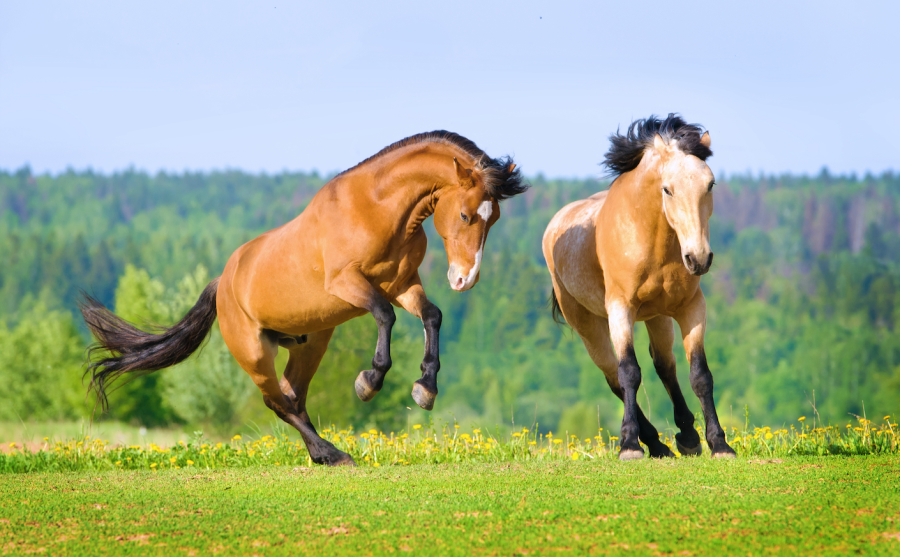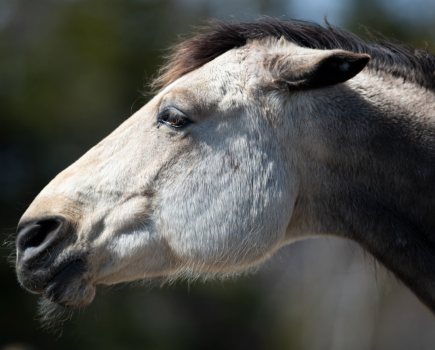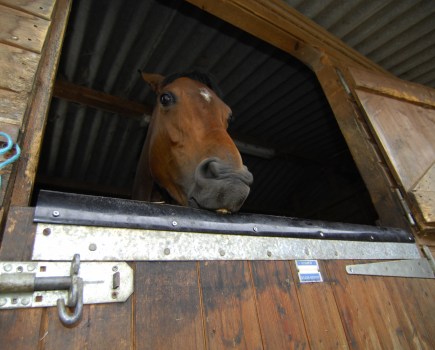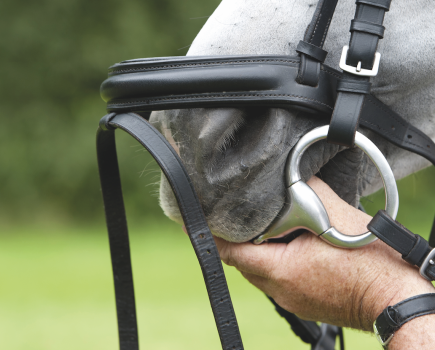When learning about horse behaviour and what they are trying to tell us through body language, we need to put together three pieces of a jigsaw. Firstly, consider that horses use their whole body to communicate. Messages may be conveyed via several movements or positions, so body language signals can only be interpreted correctly when the horse’s body is seen as a whole. For example, facial expressions may be supported by the position or movements in the rest of the body. The position of the head and neck, hindquarters and tail are of particular importance, as is overall body posture.
If your horse has their ears back, for example, they may either be listening to something behind them or threatening to bite. The position of their head and neck — high and alert when listening, or low and extended towards you when aggressive — can help us to understand what they are saying. I explain more about this later in the article.
Secondly, consider that a horse’s body language and behaviour is context specific. How a horse behaves can mean different things in different situations, so it’s vital to take the context or situation in which the behaviour occurs into account.
Thirdly, body language and horse behaviour can differ between individual equines. Not all horses respond to things in the same way. Some are extremely stoic and may be much more frightened or stressed than their body language suggests. This can be particularly true of coldblooded horses like cobs and Shires, who may freeze if they are frightened rather than spook or run about. Conversely, hot-blooded breeds like Arabs and Thoroughbreds may be very reactive and expressive in their behaviour and body language if they are anxious.
Horse body language: the head and neck
The position of the head and neck can tell you a lot about how a horse is feeling. Often horses will raise their heads when aroused, fearful, or threatened. They will arch their necks in response to a threat, and head threats can quickly escalate to lungeing and charging. Stallions bow their heads when they meet one another and ‘snake’ their necks when herding members of their bands.
Elevated head
If your horse raises their head, they may be focusing on something in the distance and be deciding whether to flee, ignore, or investigate it. If they raise their head while being ridden, this could be an early sign of pain. Further indicators could be if the horse hollows their back, puts their ears back, shakes their head, or swishes their tail.
Lowered head
A lowered head can be a sign that your horse is relaxed, resting, in pain or even depressed. Taking their overall body posture into account can help you to differentiate between these emotional states.
Head tossing
This indicates that a horse may be frustrated, irritated, or in pain. They may grind their teeth, toss or fling their head, open their mouth, or elevate their head to avoid a rider’s hands or the bit when ridden. There is usually an overall stiffness to the body.
Head turned away
If a horse turns their head away when you approach this may be an indicator that they are worried about you or what you’re about to do. Horses will often turn their head away when their owners arrive with their tack or travel bandages as they are anticipating that a stressful event is about to occur.
Body language: the horse’s tail
What a horse does with their tail is often overlooked, but it can be a great indicator of their emotional state and is an important part of understanding body language.
Raised tail
A tail raised straight up is a sign of excitement. It’s often seen when playing or when something has caught a horse’s attention.
Swishing their tail slowly
This is usually to get rid of flies, but it can also be seen if a horse is becoming colicky. In this case you may also see the horse stamping their feet, as well as kicking at their stomach, dropping their head, looking at their hindquarters, or attempting to get down. Tail swishing when ridden can be a sign of discomfort or anxiety.
Swishing their tail rapidly
When a horse’s tail swishes quickly from side to side or up and down, they are irritated, in pain, or aggressive. This may be a warning sign that your horse is about to buck, kick or bite.
Clamped down tail
A fearful or stressed horse will clamp down their tail tightly and may also lower their hindquarters. If your horse clamps down their tail when you’re riding, they may be fearful or in pain, so assess the situation — they might feel that you have punished them or asked too much. You may have frightened them and you’ll need to build their confidence back up.
Tail held to one side
A tail held like this can often be a sign of back pain in a horse.
In all of the above scenarios, if you spot any of the behaviours associated with pain in your horse, have your tack fit checked by a master saddler and ask a vet to examine your horse for any potential physical problems.
Horse body language: warning signs
When a horse is anxious or sees something new, their posture becomes upright and their head and tail raised. For example, if a horse notices a dog in the hedge, they may alert fieldmates to the potential threat by looking straight at it, pointing their head or body in its direction and adopting a very upright stance. Their head and tail will be held high, ears tightly pricked and muscles tensed. Their movement may be stiff and jerky to signify to their friends that they are anxious about the intruder.
These postural signals may be seen by other horses from miles away and are clear indicators that something threatening requires their urgent attention. On closer inspection we might see that the horse’s eyes are open wide, clearly showing the sclera (whites of the eye), with a tense neck and facial muscles too. We may also see flared nostrils sniffing towards the source of interest and the horse may blow or snort. If they’re particularly frightened, their muscles may quiver or tremble.
Horse body language: relaxed
When a horse is relaxed, they will usually slightly lower their head and neck, while their body posture and muscles will look soft overall. Their lips and muzzle will be relaxed too and their ears will be in a ‘neutral’ position — slightly lowered and rotated to the side.
One hindleg will often be resting on the toe when a relaxed horse is standing still. If they’re moving, there will be a loose swing to their stride. The shape of their eye will be round.
Sexual differences in a horse’s body language
Mares and stallions have different postural displays in certain situations (especially when it comes to sexual behaviours) but, generally speaking, their body language is very similar. When stallions are gelded it often reduces some of their expressivity — stallions can be far more expressive in their body language than geldings. Many advanced dressage riders prefer to ride a stallion as their power and exuberant movement can be an advantage in competition. Gelding a horse also means that he will display far fewer sexual and herding behaviours.
Watch your horse’s body language
The best way to learn about a horse’s body language is to watch them as often as you can. Notice how they react when they’re in the field with other horses, when they’re taken to a new environment, when other people are around them. Watch their facial expressions and ear positions, as well as body language, noticing their overall posture and how they react in different situations.
Learning to recognise early changes in a horse’s body language and behaviour can help you to see when they are anxious, fearful, frustrated or aggressive. This puts you in a better position to avoid potentially dangerous situations, or prevent behavioural problems from escalating.
Changing what you’re doing or removing yourself and your horse from a situation could help to keep you both safe. Noticing the warning signs that your horse is irritated or fearful and acting accordingly could stop them from resorting to more more dangerous behaviours like bucking or biting.
Sophisticated body language signals
Mother Nature was clever when it came to developing the horse. As a prey species that evolved to live in social groups, using sounds could have put the entire herd at risk of being noticed by predators. As a result, horses have developed a range of sophisticated body language signals and behaviours to communicate with each other silently and safely. Of course, horses do sometimes use vocal signals, but their primary method of communicating is through body language. The better you get at reading your own horse, the stronger the bond and trust between you will be.
Main image credit: Shutterstock








